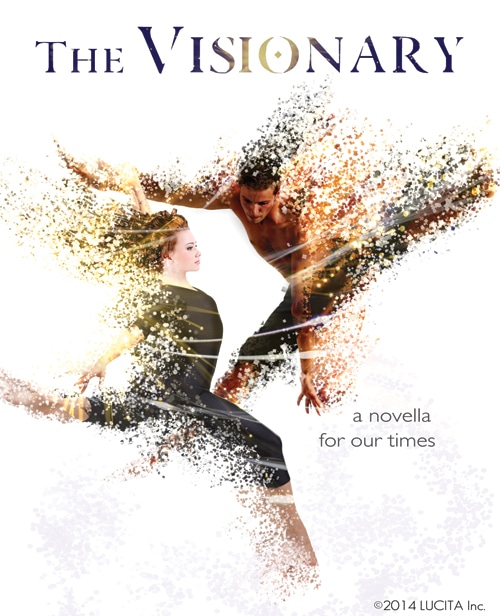How do you dramatize non fiction? Isn’t real life already wild and crazy enough? And isn’t that why we have fiction in the first place, so that we can be superheroes and E.S.C.A.P.E. our dull routine realities?
Yes, and yes, BUT. The role of literature, in my and many other authors’ humble yet strong opinion, is, in addition to the obvious benefit of enjoyment and entertainment, to reflect social trends and preserve cultural ideals. To inform, inspire, and innovate. The stories we write and read shape our culture and society, our minds and our lives. This is why I insist with the ferocity of a Category 5 hurricane on quality, beauty, and impact.
Remember when we discussed why we write? The reason I write is to open minds—including my own. For me, the most potent way to do that is by mixing up fiction and real life.
I'm no good at academic theories—I prefer living breathing examples. So let me tell you about The Visionary.
Pack It Tight and Give It Time
The Visionary is, to date, my most complex, creative, and insanely challenging work. It's several decades of thought and observation about nearly every aspect of the human experience vacuum-packed into a 12,000-word sardine can. I dramatize only a little.
Short version: It’s a work of dramatic realism (see below for definition) written in poetic prose that explores the nature and role of time, light, and the human capacity for vision, and exhorts us to re-imagine and reconfigure the habits and systems that have rendered us completely blind to our own potential.
Short short version: It's an inspirational critique of modern Western society. (Note how “inspirational” tempers “critique”—the message is, yep we've royally messed up ourselves, our society, the economy, and the planet, but there's hope!)
Long version: You gotta read the book. If you can summarize it better than me I'll send you a box of dark chocolate truffles.
It took me twelve years to finish it, because it took that long for me to amass enough experience, acquire enough knowledge, and attain enough insight and inspiration to be able to craft metaphors powerful and evocative enough for the expansive range of concepts and ideas that this work covers. It took that long to experience and then interweave the real life events that inspired the story among those metaphors, and to give it symmetry and structure that not only made sense and delivered a narrative, but also read and felt poetic. Plus I was busy living all that real life stuff.
Choose Your Poison (or, Form vs Function)
Dramatization takes varied and multiple forms. Docudramas are dramatizations in film or video. In literature we have realism in general, which depicts actual life. We also have magic realism, made famous by Gabriel García Márquez, where magical elements abound in an otherwise realistic environment or world. There’s realistic fiction, which is believable or plausible fiction (zombie, alien romances, and 50 shades of anything need not apply). You might have also heard of the non fiction novel, which employs historical figures and events intertwined with fictional elements; it can also be an autobiographical or semi-autobiographical novel.
When I was searching for the appropriate genre to label The Visionary, I found myself constantly falling through the cracks. So I employed a rarely used term: “dramatic realism.” It's apparently so rare it's not anywhere in the usual literary genre lists you'll find. The one place I found that does list the term couldn't bring itself to express it in a single sentence. So I did. I define dramatic realism as
“literature or creative writing that reflects reality or the real world the way we experience it with all of its subjective implications, and expresses that experience in a dramatic or dramatized, although not fantastical or magical, manner.”
Whew. At least it's one sentence.
Mind you, I put the label on the work after the fact. You don't—ok, some might but I don't—set out to tell a story by selecting the style first. The form needs to fit the function. In this case, had I “chosen” any other genre, it would have either come out reading like an accidental offspring of Dalí and Shakespeare or it would have made Marcel Proust look like Augusto Monterroso.
Plot Your Path and Don't Forget to Live
Bottom writer's line, you have to develop a gut-level feel for the genre and style that your stories call for, regardless of the subject matter or plot. The way to do that is to become familiar with all of the genres and subgenres that have come before you, and to play with them, the way you would in a sandbox. Especially when you're mixing salt and freshwater—fiction and real life, as it were.
My personal advice is, be clear, very clear, on what you are trying to dramatize and why. Dig deep. What is it deep inside that's making you want to express [fill in the blank]? Who are you writing for and why? How do you wish to grow as a writer through this work?
Above all, remember it IS real life you're dramatizing, so that's the first step. Get out there, update your passport, log out of social media, and experience life in all of its maddening, beautiful, intricate simplicity.
And then tell us about it.
What aspect of life have you always wanted to dramatize?
PRACTICE
Choose an element of real life or the real world around you and write about it in dramatic realism.
And if you're feeling dramatically unreal, you can write about that too. Just be sure to use some kick-ass metaphors.








The Visionary is, to date, my most complex, creative, and insanely challenging work. It’s several decades of thought and observation about ((nearly aspect)) of the human experience vacuum-packed into a 12,000-word sardine can. I dramatize only a little.
You are missing the word “every” in there.
Tx Nathan, that has been corrected.
I have a memory from childhood that I can relate. It is real, though something happened I cannot explain. It is not supernatural. It is something intense experienced by a child, who, in trying to process the event, has no other interpretive tools than what he/she has seen and heard in books. It’s like a real-life story of a child I worked with at school, who at the age of five witnessed his father attempt to murder his mother. The little boy told me, “A T-Rex came in our house, and tried to kill my mom!” I have no idea what classification fits this genre, of drama as explained by an innocent. Here’s my story, and I swear to God it is true.
I was very young, probably five or six, just learning to read, and I was one of those kids that picks it up quickly. In first grade I was reading fifth and sixth grade books. At home I had lots of books too. My parents never spent money on me, so my grandparents and friendly neighbors gave me books. One of the books I received from Lillian, next door, was a book called The Human Body. It had belonged to her son, who by then was a teenager. It was well-worn, as if her boy had loved it, and I really loved it too. I was especially fascinated by pictures of the heart. Nothing like pink and red Valentine hearts, the ones in the book were hand-rendered, in shades of greyish pink and tan.
At this time I was also learning to spell, and easily figured out simple, one syllable words like “cat”, “dog”, or “cup”. One afternoon, I was sitting in the small living room of our dingy apartment, thinking of short words, figuring out how to spell them, and writing them on a list. One little word had me stumped. “Are”. I knew the word, and I knew I could read the word if I saw it, but I could not remember what it looked like, and when I tried to spell it phonetically, it didn’t look right. “R”? “Ar”? “Arr?”.
My father wandered into the room, in t shirt and dirty pants as usual. Though recently discharged dishonorably from the US Marine Corps, he kept his Jarhead haircut and kept his jaw squared, as if to prove he was too much man for them, not the other way around. He lit a cigarette and walked toward the kitchen, when I thought he might help me.
“Daddy, how do you spell ‘are’ “? He whirled around and yipped and laughed like a hyena. “R?” “R?” “How do you spell the letter R?” “It’s a letter, stupid!” “You don’t spell a letter, you just write the letter!” “How could you be so dumb?” He stomped back to the bedroom where my mother was sitting, and he shouted and laughed, “R!”, “R?”, “R?”, “R!” all the way. I heard him loudly tell my mother about my incredibly stupid question.
My mother’s response was, “Why do you bother to talk to her? You know she’s a waste of time. She’s a retard!”
I put down my book and walked over to the window quickly. I was working on acting indifferent, as if nothing they said bothered me. I had already learned, in that house, things might be unpleasant, but if you cried about it, then life could get really nasty. So I tried to stay dry-eyed, and distracted myself by looking down from our 2nd story window to the filthy cement courtyard below, where some neighborhood boys were playing on skateboards.
They rolled back and forth, and disappeared and reappeared, as they rode around the postwar tenement building. While I was concentrating on not crying at all costs, I also felt a strange unpleasant burning inside my chest. You know that feeling, if you are holding something in your hand, and someone rips it away from you, the friction of that violent pull leaves a burning on your skin? That is how I felt inside my chest, like something had been ripped out and had scraped the inside of my skin in the process. I didn’t know what it was, but it was getting strong enough to distract me from crying.
Still watching the boys below, and now trying to stop paying attention to my chest pain, I saw something come around the corner on a skateboard, and it wasn’t human. The skateboard was rolling, with something on it, but it was definitely not a person. I tried to see if someone had put a box or big toy on the skateboard, but the object didn’t match any of those ideas. The shape was familiar, but all I could really see was a weird pinkish grey color. As it rolled directly beneath my window, I finally had the perspective I needed, and I could see the whole thing. It was a huge heart.
I couldn’t believe what I had just seen, as the skateboard with the heart on it rolled around the corner. I waited for it to come back around with the kids, but it never returned. I went outside and looked everywhere, but could not find it. I was too embarrassed to ask anyone about it; I knew the other kids would not believe me. I remember finally returning to our apartment building, and sitting on the bottom steps for a long time, till dark. I knew I had seen a heart roll away on a skateboard. And I knew that it was mine.
Avril, I had to read and re-read your story, and each time it brought tears to my eyes. We too lived in tenement housing when we first came to this country years ago, with all of five suitcases and nothing else; and the situation at home wasn’t always rosy. But the exterior doesn’t matter as much if there’s love. In your case neither parent seemed to care much?? The things that children are forced to go through, too often by those who should, ideally, love and protect them most, are beyond words sometimes. My sister works with abused children from time to time and it’s heartbreaking the stories she tells.
The symbolism and meaning in what you experienced as a child indicates a powerful soul, a strong and willful heart—and a writer’s mind. Good for you Avril. Stay on that. I think if you expanded this into a short story it would be an amazing piece of writing.
Birgitte, thank you for your comments. I’ve never considered that for a short story, but I will now. I appreciate hearing that you detected resiliency in my 5 year old self. That is the only reason I would relate a depressing story like that.
It is a story, Avril, and very well told. Maybe for you it is a way of wrapping up what happened but the way you don’t simply tell but show through metaphors turned it into an event that I felt I was experiencing for myself.
Even more, you communicated something that I have struggled to put into words. I, too, saw and heard things that were real to me, that were my mind’s response to fear and isolation- but also the mind’s attempt to take charge of a situation. It is not simple hallucination but symbolism. I hadn’t realized that until I read your story.
Mark
Thank you Mark. It was a challenge to write about an intense childhood experience, hoping adults would find it credible. I appreciate your comments.
Avril my name is kofi and am a small writer from Africa. well am learning a lot from you,those who comments and replies on your wall. I will be very happy if we can be friends on facebook. i think i need more lesson from..
Hi Birgitte! First, the cover of your new book is extraordinary in creativity and allure. It beckons. I have read only the first pages online and can’t wait for my own copy.
As far as your prompt, a story pulses in my brain after watching classes of six-year-old students participate in an “Intruder Drill” last week. They were too young to understand the full implication of the drill, so innocent, so trusting. How do we share with them the effects of evil in our world and how do we overcome it? Searching for the vision.
I’m eager to fight for the dark truffles!
Hi Ruth! Thanks for the kind words, I would love to know what you sincerely think. And yes please do fight for the truffles, it’s worth it! 😉
The point you bring up about children and their innocence matters more than perhaps any other. I would say, though, that children are extraordinarily capable of understanding what we would consider rather sophisticated or “older” concepts. One way that ancient cultures passed on knowledge and awareness to their younger generations is through mythology—and a lot of cultures have some pretty fearsome gods and stories! I feel there is a way to do this, in our modern society, using our own mythology.